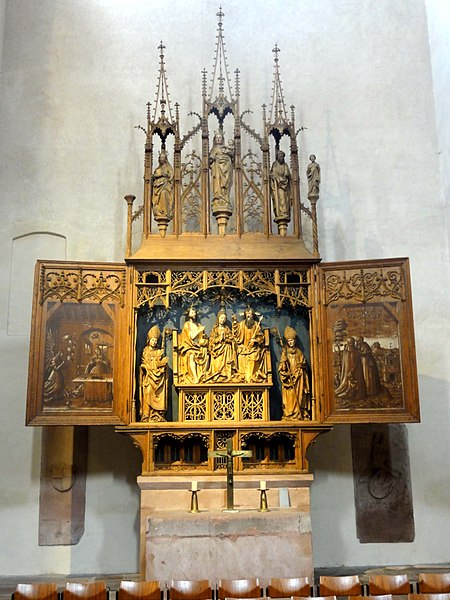Alpirsbach Abbey is a former Benedictine monastery and later Protestant seminary located at Alpirsbach in Baden-Württemberg, Germany. The monastery was established in the late 11th century and possessed considerable freedoms for an ecclesiastical property at that time, but in the 13th century it became a de facto possession of the Dukes of Teck and then the County of Württemberg. In the 15th century, the monastery enjoyed economic prosperity and was expanded but was dissolved with the conversion of the by-then Duchy of Württemberg to Lutheranism in the 16th century. The monastery became a seminary and boarding school until the 17th century and was physically reduced over the 19th century by land sales and demolition. Over the second half of the 20th century, the monastery was turned into a cultural fixture with annual concerts of Classical music and a museum of its history.
Alpirsbach Abbey
Alpirsbach Abbey from the north, 1881
Tympanum above the door into the abbey church
Altar of St. Mary
The Benedictines, officially the Order of Saint Benedict, are a mainly contemplative monastic religious order of the Catholic Church for men and for women who follow the Rule of Saint Benedict. The male religious are also sometimes called the Black Monks, in reference to the colour of their religious habits, in contrast to other Benedictine orders such as the Olivetans, who wear white. They were founded in 529 by Benedict of Nursia, a 6th-century Italian monk who laid the foundations of Benedictine monasticism through the formulation of his Rule. Benedict's sister, Scholastica, possibly his twin, also became a religious from an early age, but chose to live as a hermit. They retained a close relationship until her death.
Saint Benedict of Nursia (c. 480–543). Detail from a fresco by Fra Angelico (c. 1400–1455) in the Friary of San Marco Florence.
Abbey of Monte Cassino
Melk Abbey
Abbatiale Saint-Benoit, southern aspect as in 1893








